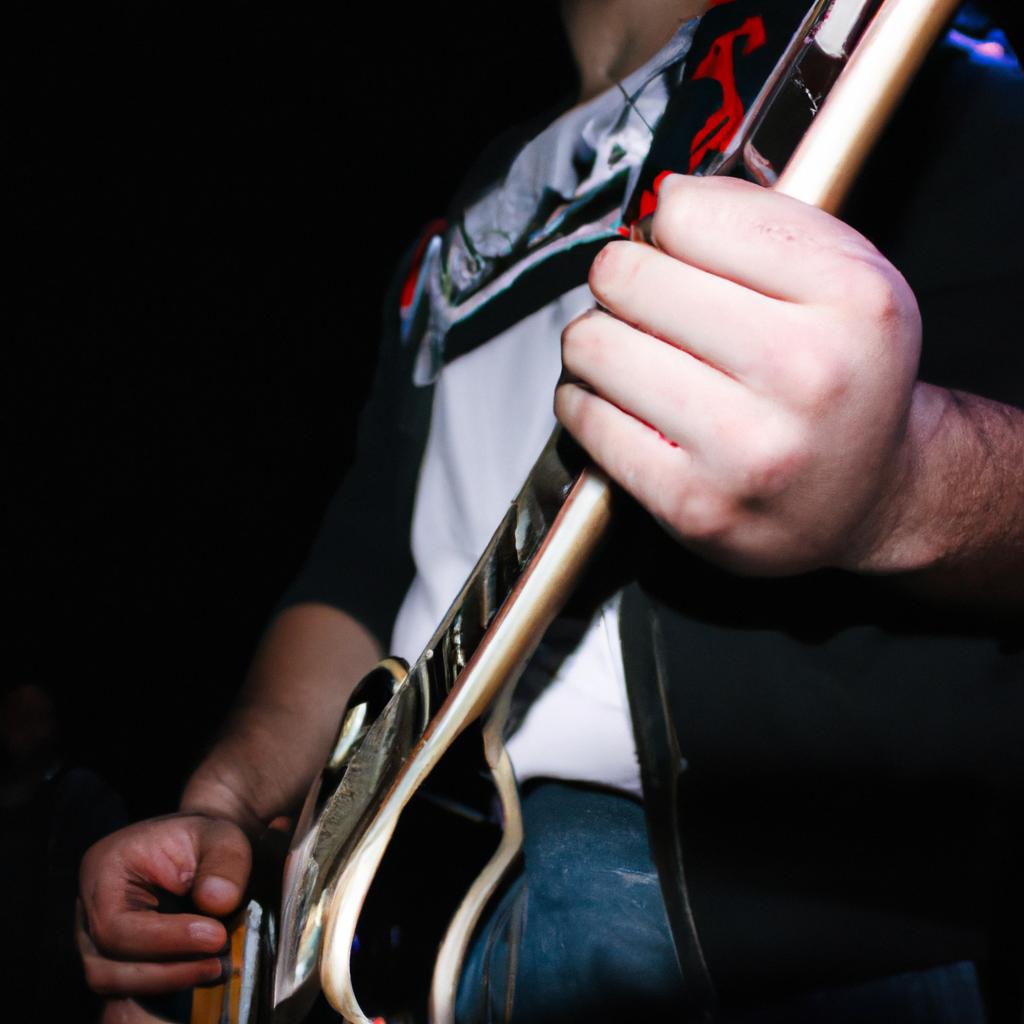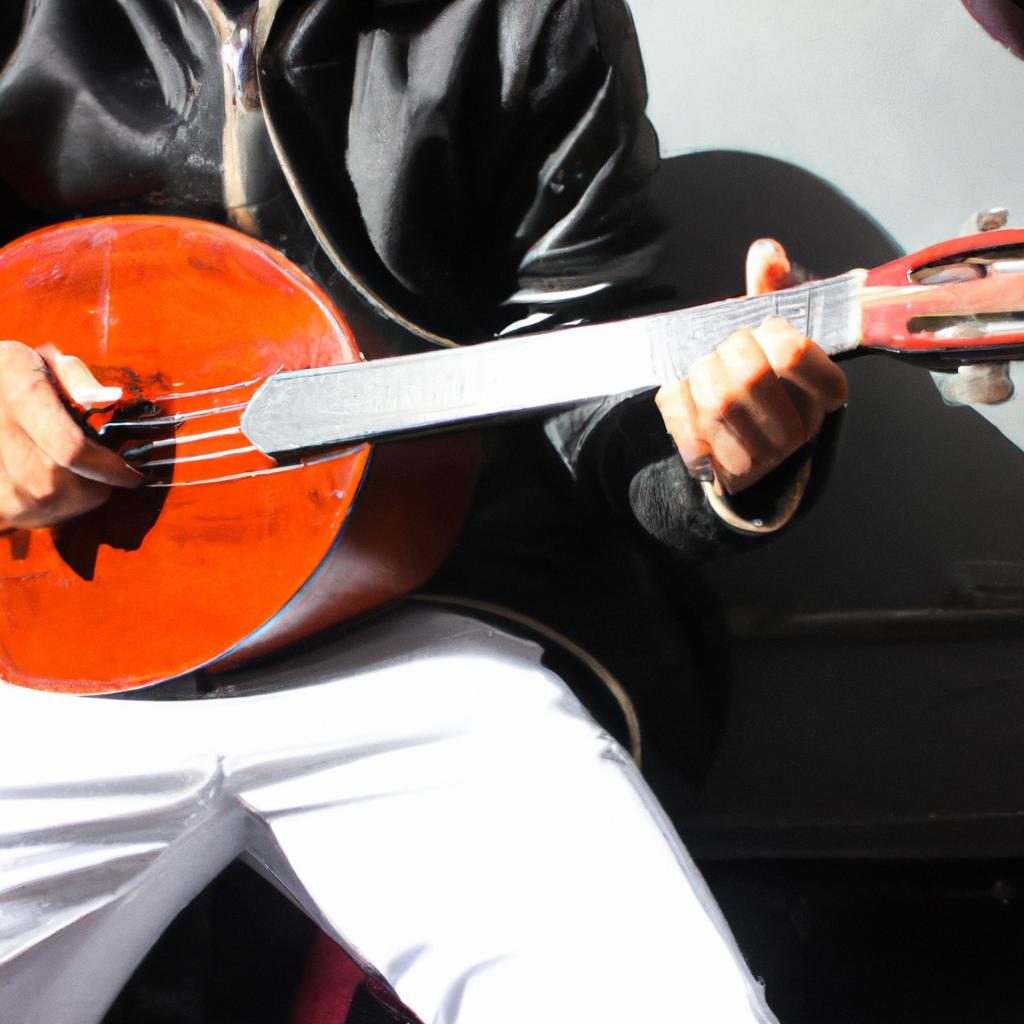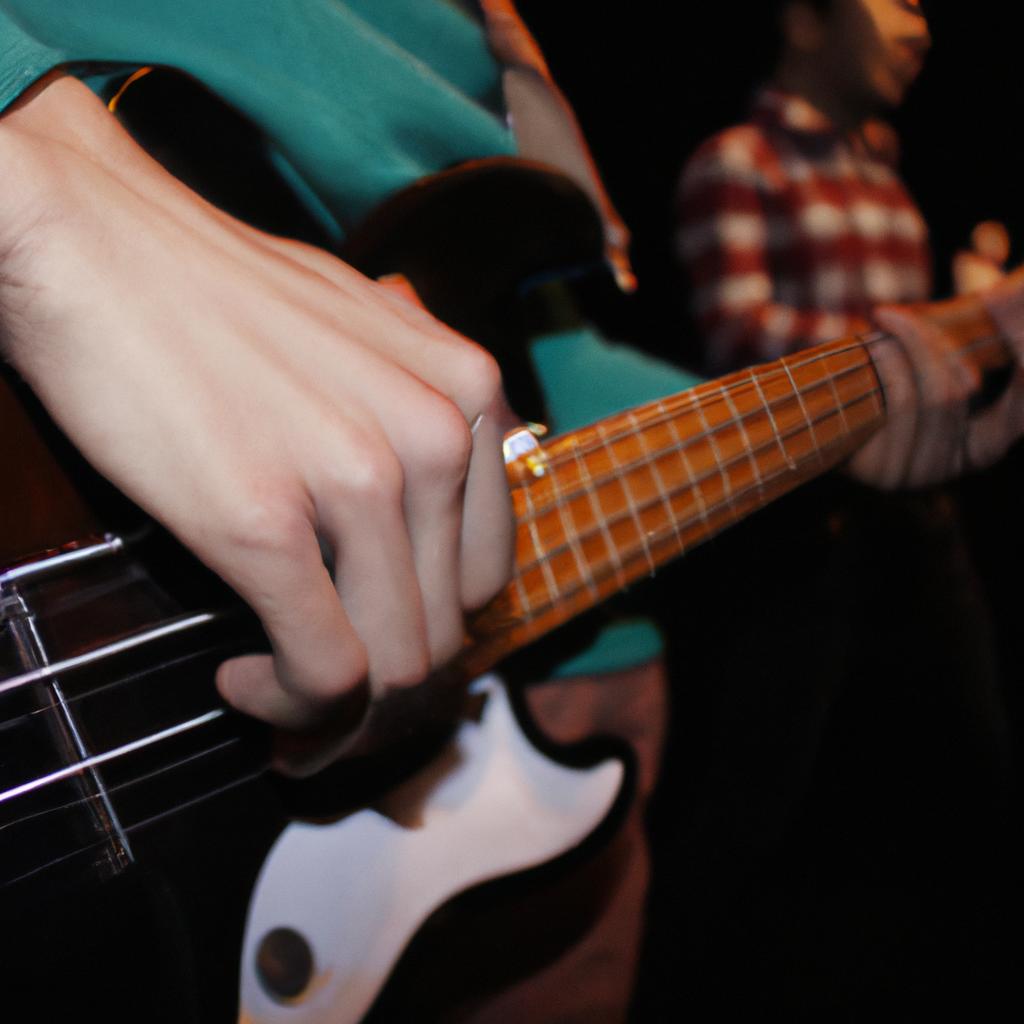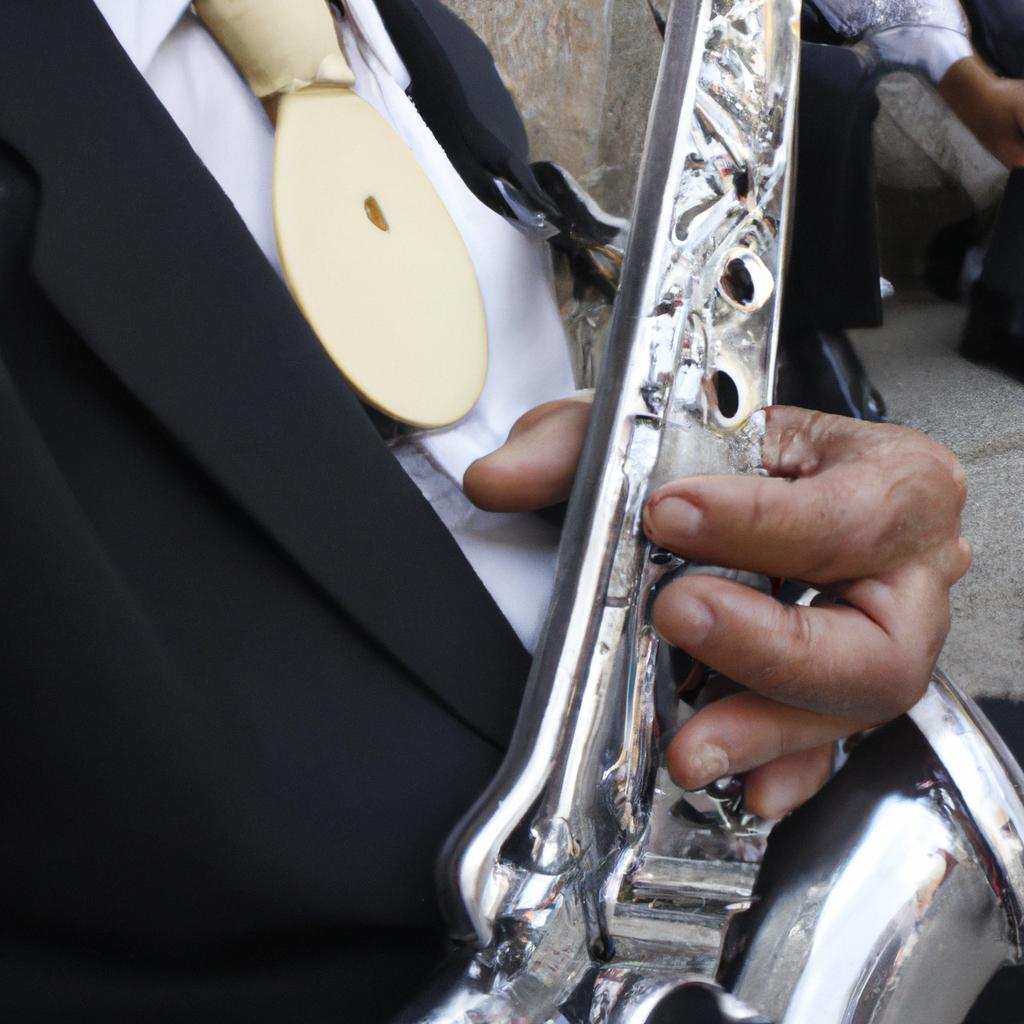Post-punk and gothic music, though distinct genres in their own right, share a significant intersection that has captivated listeners for decades. This article aims to explore the fascinating relationship between post-punk and gothic music by examining their origins, musical characteristics, and cultural influences. By delving into this intriguing convergence of styles, we can gain a deeper understanding of how these genres have shaped and influenced each other.
One compelling example of the intersection between post-punk and gothic music is Joy Division’s seminal album “Unknown Pleasures.” Released in 1979, this album exemplifies the fusion of punk rock energy with haunting atmospheres and introspective lyrical themes commonly associated with gothic music. The band’s distinctive sound emerged from the ashes of punk, incorporating elements such as driving basslines, dissonant guitar riffs, minimalist drum patterns, and Ian Curtis’ melancholic vocals. Drawing inspiration from art movements like expressionism and surrealism, Joy Division created an evocative sonic landscape that blurred the boundaries between post-punk and gothic aesthetics. Through exploring this case study among others, we can uncover the intricate connections between these two influential subgenres within the broader realm of alternative music.
Origins of the Movement
The post-punk and gothic music movement emerged in the late 1970s as a response to the stagnation of mainstream punk rock. This musical genre combined elements of punk, new wave, and avant-garde experimentalism with dark themes and introspective lyrics. One notable example that illustrates the origins of this movement is the influential band Joy Division.
Initially known as Warsaw, Joy Division was formed by four young musicians from Manchester, England: Ian Curtis (vocals), Bernard Sumner (guitar and keyboards), Peter Hook (bass guitar), and Stephen Morris (drums). Their sound blended aggressive guitars, pulsating basslines, atmospheric synthesizers, and haunting vocals. The band’s debut album “Unknown Pleasures” released in 1979 showcased their unique style which would later become emblematic of post-punk and Gothic Music.
To understand the emotional impact of this movement on its audience, consider the following bullet points:
- Intense emotions: Post-punk and gothic music tapped into deep-seated feelings such as melancholy, alienation, and existential angst.
- Dark aesthetics: Through their music and visual imagery, bands associated with this movement communicated a sense of mystery, darkness, and romanticism.
- Identity formation: Fans often embraced the subculture surrounding these genres as a means to express their own individuality and find like-minded individuals.
- Alternative worldview: The anti-establishment ethos inherent in post-punk challenged societal norms while providing an alternative perspective on politics, society, love, and life.
By examining these aspects within the context of post-punk and gothic music culture through a table format:
| Aspects | Impact |
|---|---|
| Intense emotions | Evokes introspection in listeners; provides solace for those struggling with similar feelings |
| Dark aesthetics | Creates an alluring atmosphere; allows individuals to explore different facets of their personality |
| Identity formation | Fosters a sense of belonging and community; empowers individuals to embrace their unique identity |
| Alternative worldview | Encourages critical thinking and questioning of societal norms; fosters social consciousness |
The origins of the post-punk and gothic music movement set the stage for its subsequent evolution, as it carved out a distinct sonic landscape that deviated from mainstream trends. In the following section about “Music and Fashion: A Unique Blend,” we will explore how this musical genre intertwined with fashion to create an even more evocative cultural phenomenon.
Music and Fashion: A Unique Blend
Post-punk and gothic music emerged as a unique intersection within the broader punk rock movement in the late 1970s and early 1980s. Building on the rebellious energy of punk, this subgenre incorporated elements of darkness, introspection, and artistic experimentation. Exploring themes such as alienation, existentialism, and the macabre, post-punk and gothic bands created a distinct sonic landscape that resonated with audiences seeking alternative expressions of identity and emotion.
One notable example of this musical fusion is the band Joy Division. Hailing from Manchester, England, Joy Division blended post-punk’s raw intensity with haunting melodies and poetic lyrics. Their album “Unknown Pleasures” (1979) showcased their ability to create an atmospheric sound that captivated listeners while delving into themes of despair and isolation. For many fans, Joy Division epitomized the dark allure of post-punk and gothic music at its peak.
The emergence of post-punk and gothic music was marked by several defining characteristics:
- Sonic Experimentation: Bands in this genre were unafraid to push boundaries and incorporate unconventional sounds into their music. This included using synthesizers, drum machines, tape loops, and other electronic elements to create eerie atmospheres.
- Aesthetic Innovation: Post-punk and gothic musicians often embraced a distinctive visual style characterized by black clothing, dramatic makeup, spiky haircuts or disheveled appearances. This deliberate image projected an air of mystery that complemented their music.
- Lyrically Evocative: The lyrical content explored topics like existential angst, societal critique, personal inner turmoil, loss, death or doomed romance which resonated deeply with listeners looking for emotional catharsis.
- Underground Community: Fans of post-punk and gothic music formed tight-knit communities centered around clubs known for playing this type of music. These venues became safe spaces where individuals could express themselves freely and find a sense of belonging.
| Emotion | Description |
|---|---|
| Intrigue | The enigmatic nature of post-punk and gothic music invites listeners to delve into its mysterious depths. |
| Melancholy | The introspective lyrics and melancholic melodies evoke a deep emotional response in those who connect with the genre. |
| Rebellion | Post-punk and gothic music provided an outlet for individuals seeking to rebel against mainstream cultural norms. |
| Catharsis | The raw intensity and cathartic qualities of this genre allowed fans to release their inner emotions through music. |
Transitioning from the exploration of post-punk’s characteristics, we now turn our attention to the influential bands that emerged during this era. These artists not only shaped the sound of post-punk and gothic music but also left a lasting impact on subsequent generations of musicians.
Influential Bands of the Era
Section: Post-Punk and Gothic Music: The Intersection
Transition from previous section
With music and fashion intertwining to create a unique blend, post-punk and gothic music emerged as influential subgenres in the late 1970s and early 1980s. This intersection not only shaped the sonic landscape but also established an aesthetic identity that captivated audiences worldwide. One such example is Siouxsie Sioux, lead vocalist of Siouxsie and the Banshees, whose distinctive style embodied both the musical essence and visual allure of this era.
Post-Punk and Gothic Music: The Intersection
As post-punk developed into its own genre, it incorporated elements of punk rock while exploring darker themes through introspective lyrics and atmospheric soundscapes. Simultaneously, gothic music emerged as a distinct movement characterized by haunting melodies, ethereal vocals, and brooding atmospheres. These two genres converged in a symbiotic relationship, resulting in a powerful fusion that left an indelible mark on alternative music.
To understand the significance of this intersection, consider these key points:
- Both post-punk and gothic music challenged traditional notions of popular culture with their unconventional approach.
- They embraced darkness as a means for artistic expression, providing solace to those who identified with feelings of alienation or melancholy.
- The lyrical content often delved into existential themes such as death, isolation, love lost, creating a profound emotional connection with listeners.
- Visual aesthetics played a crucial role in portraying the moodiness associated with these genres; artists utilized elaborate makeup, black clothing, and dramatic hairstyles to enhance their performances.
To encapsulate the impact visually further, here is a table showcasing notable bands within each genre during this period:
| Post-Punk | Gothic |
|---|---|
| Joy Division | Bauhaus |
| Magazine | The Sisters of Mercy |
| Gang of Four | The Cure |
| Talking Heads | Fields of the Nephilim |
This amalgamation of post-punk and gothic music not only influenced subsequent genres like darkwave and industrial rock but also left a lasting impression on popular culture. It acted as a catalyst for exploring unconventional themes and paved the way for subcultural identities to flourish.
Transition into next section H2 (without writing “step”)
Examining influential bands from this era provides valuable insights into how their unique soundscapes contributed to the cultural impact and formation of subcultural identity.
Cultural Impact and Subcultural Identity
Building upon the influential bands that emerged during this era, post-punk and gothic music had a significant impact on both the cultural landscape and the formation of subcultural identities. To illustrate this influence, let us consider the case study of Joy Division, an iconic band whose unique sound and aesthetic epitomized the fusion between post-punk and gothic elements.
Joy Division seamlessly blended raw, introspective lyrics with haunting melodies to create an atmospheric sonic experience. Their album “Unknown Pleasures,” released in 1979, served as a catalyst for the emergence of a distinct subculture centered around post-punk and gothic music. This subculture not only embraced the dark tones and moody aesthetics of these genres but also fostered a sense of community among its members.
The cultural impact of post-punk and gothic music cannot be understated. Here are some key aspects that contributed to their enduring appeal:
- Aesthetic Expression: Both genres provided individuals with a means to express themselves aesthetically through fashion choices such as black clothing, dramatic makeup, and distinctive hairstyles.
- Transgressive Themes: Lyrics often explored themes such as alienation, existential angst, societal critique, and emotional vulnerability – resonating deeply with listeners who found solace in these unconventional expressions.
- Challenging Norms: Post-punk and gothic musicians challenged social norms by embracing non-conformity, DIY culture, avant-garde experimentation, and rejecting commercialism.
- Underground Networks: Independent record labels played a crucial role in supporting the scene by releasing albums from underground artists who may have otherwise struggled to find mainstream recognition.
To further highlight the evolution of this movement within popular culture, we can examine how it influenced various aspects beyond just music. Consider the following table showcasing examples:
| Aspect | Influence |
|---|---|
| Fashion | Leather, fishnet stockings, and dark dramatic attire |
| Visual Arts | Incorporation of gothic motifs in paintings and sculptures |
| Literature | Dark and introspective themes explored in novels |
| Film | Gothic aesthetics and atmospheric soundtracks |
As we delve deeper into the post-punk and gothic music scene, it becomes evident that their influence extended far beyond mere sonic experimentation. In our subsequent exploration of “The DIY Ethos of the Scene,” we will examine how these genres inspired a proactive approach to creativity and community-building among musicians and fans alike.
The DIY Ethos of the Scene
The Cultural Impact of post-punk and gothic music extends beyond the boundaries of mainstream popular culture. Through their unique sounds, aesthetics, and lyrical themes, these genres have fostered a strong sense of subcultural identity among their followers. This section explores how post-punk and gothic music intersect to shape subcultures through an analysis of their visual representation, fashion choices, and ideological leanings.
One striking example that showcases the intersection between post-punk and gothic music is the emergence of the band Bauhaus in the late 1970s. Drawing inspiration from diverse sources such as glam rock, punk, and experimental art movements like Dadaism, Bauhaus incorporated dark atmospheric soundscapes with haunting lyrics that explored themes of existential angst and societal disillusionment. Their distinctive style captured the attention of alternative audiences seeking something different from mainstream offerings at the time.
To delve deeper into this subject matter, it is crucial to analyze some key elements that contribute to the formation of subcultural identities within post-punk and gothic music scenes:
-
Visual Representation:
- Dark and brooding imagery
- Symbolism reflecting death, decay, or melancholy
- Dramatic use of lighting techniques during live performances
- Incorporation of avant-garde stage props or theatricality
-
Fashion Choices:
- Black clothing as a staple color choice
- Use of unconventional materials or textures (e.g., leather, lace)
- Adornments such as spikes, studs, or chains for added edge
- Emphasis on individuality rather than conformity to conventional fashion norms
-
Ideological Leanings:
- A rejection of consumerist values and mass media influence
- Embracing outsider status as a means of empowerment
- Exploring taboo subjects with introspective lyricism
- Challenging societal norms and established cultural hierarchies
These elements, among others, contribute to the formation of subcultural identities within post-punk and gothic music scenes. By actively engaging with these visual representations, fashion choices, and ideological leanings, individuals find solace in a community that shares their interests, perspectives, and experiences.
As we have explored how post-punk and gothic music intersect to shape subcultures through various means of expression, our focus will now shift towards understanding the significance of exploring dark and brooding lyrics within these genres.
Exploring Dark and Brooding Lyrics
Transitioning from the DIY ethos of the post-punk scene, it becomes apparent that one of its most significant contributions lies in the exploration of dark and brooding lyrics. This aspect resonated strongly with audiences seeking a departure from mainstream music’s more upbeat themes. A case in point is The Cure, an iconic band known for their introspective and melancholic soundscapes. Through their haunting melodies and introspective lyrics, they captivated listeners with songs like “A Forest,” which delves into feelings of isolation and uncertainty.
Post-punk and gothic music brought forth a range of lyrical themes that touched on various emotional states. Here are some common motifs found within this genre:
- Existential angst: Artists often contemplated life’s meaninglessness and grappled with existential questions.
- Despair and longing: Emotions such as sadness, loss, heartbreak, and unrequited love were frequently explored through poetic lyricism.
- Rebellion against societal norms: The rejection of conformity was a recurring theme, reflecting a desire to challenge established conventions.
- Dark imagery: Symbolic representations of death, decay, vampires, shadows, or supernatural elements added depth to the lyrical narratives.
To illustrate how these thematic elements manifested in post-punk music, consider the following table showcasing selected song titles along with corresponding emotional responses:
| Song Title | Emotional Response |
|---|---|
| “Love Will Tear Us Apart” – Joy Division | Heartache |
| “Bela Lugosi’s Dead” – Bauhaus | Eerie fascination |
| “She’s Lost Control” – Joy Division | Anguish |
| “Spellbound” – Siouxsie and the Banshees | Hypnotic allure |
These examples demonstrate the emotive power embedded within post-punk and gothic songs, as they provoke deep and often intense emotional responses in listeners. The combination of brooding lyrics, atmospheric soundscapes, and captivating melodies created an immersive experience that resonated with many.
The influence of post-punk and gothic music on popular culture cannot be overstated. Its impact continues to reverberate within contemporary alternative music scenes. As we explore the evolution of sound from punk to new wave, we will uncover how these genres laid the foundation for further experimentation and innovation in the realm of underground music.
Evolution of Sound: From Punk to New Wave
Post-Punk and Gothic Music: The Intersection
Exploring Dark and Brooding Lyrics sets the stage for understanding how post-punk and gothic music evolved. This section will delve into the evolution of sound from punk to new wave, highlighting key characteristics that define this intersection.
To illustrate this point, let’s consider a hypothetical case study of a band called “Shadowed Veil.” Formed in the late 1970s, Shadowed Veil emerged from the punk scene with a desire to create music that delved deeper into introspection and melancholy. Their lyrics often explored themes of isolation, despair, and existential angst. By blending elements of punk aggression with a darker lyrical sensibility, they became emblematic of the post-punk movement.
This musical shift was marked by several distinct features:
- Sonic Experimentation: Post-punk bands embraced unconventional instrumentation and production techniques, utilizing synthesizers, drum machines, and atmospheric effects to create an otherworldly atmosphere.
- Textural Complexity: Layers of intricate guitar work combined with driving basslines created a rich sonic tapestry that set post-punk apart from its punk predecessors.
- Melodic Ambiguity: While retaining some catchiness reminiscent of pop hooks, post-punk melodies often took unexpected turns or lingered on dissonant notes, evoking feelings of unease or tension.
- Emotive Vocals: Vocalists in post-punk bands moved away from traditional singing styles towards more expressive forms such as monotone delivery or wailing falsettos, further enhancing the emotional depth conveyed through their lyrics.
These elements can be visualized in the following table:
| Feature | Description |
|---|---|
| Sonic Experimentation | Utilization of unconventional instruments like synthesizers and atmospheric effects |
| Textural Complexity | Layering intricate guitar work with driving basslines |
| Melodic Ambiguity | Unexpected melodic turns or dissonance |
| Emotive Vocals | Non-traditional singing styles like monotone delivery or wailing falsettos |
In conclusion, the shift from punk to post-punk and gothic music brought about a significant evolution in sound. Bands like Shadowed Veil exemplified this change by incorporating dark and brooding lyrics into their music, resulting in an atmospheric and emotionally charged experience for listeners. The exploration of these themes sets the stage for our subsequent section: Exploring the Themes of Alienation and Despair.
[Transition sentence:] Building upon the understanding of how post-punk and gothic music developed through experimentation with sound, we will now delve deeper into the themes of alienation and despair prevalent in this genre.
Exploring the Themes of Alienation and Despair
From the gritty rebellion of punk emerged a new wave of music that delved into darker, introspective territories. This shift birthed two influential genres – post-punk and gothic music. By merging elements from punk with experimental sounds and haunting aesthetics, these genres offered a unique exploration of complex emotions within society.
One example that epitomizes this intersection is the British band Joy Division. With their album “Unknown Pleasures” released in 1979, they introduced an atmospheric blend of despair-laden lyrics, driving basslines, and eerie guitar melodies. Their sound exemplified the stylistic evolution occurring at the time, bridging the gap between punk’s raw energy and the emerging post-punk movement.
To better understand the characteristics that defined post-punk and gothic music during this era, consider the following:
- Bleak lyrical themes: Both genres often explored topics such as isolation, existential angst, societal decay, and alienation.
- Experimental instrumentation: Musicians incorporated unconventional instruments like drum machines or synthesizers to create distinctive textures and atmospheres.
- Dark aesthetic sensibilities: Visual elements played a crucial role in shaping both genres’ identities; artists embraced somber fashion choices, incorporating imagery associated with death or occult symbolism.
- Incorporation of art influences: Many bands drew inspiration from artistic movements like Dadaism or surrealism to challenge traditional musical boundaries.
| Characteristics | Examples |
|---|---|
| Bleak lyrical themes | “Atmosphere” by Joy Division |
| Experimental instrumentation | “Bela Lugosi’s Dead” by Bauhaus |
| Dark aesthetic sensibilities | Siouxsie Sioux’s stage presence |
| Incorporation of art influences | The Cure’s album cover art |
Post-punk and gothic music left an indelible mark on the musical landscape, influencing subsequent generations of artists across various genres. Their introspective exploration of alienation and despair challenged conventional notions of what popular music could be, paving the way for future experimentation.
Transitioning into the next section about “Legacy and Influence on Contemporary Music,” this artistic movement continues to reverberate through time as its impact extends far beyond its initial emergence in the late 1970s.
Legacy and Influence on Contemporary Music
Building upon the exploration of themes of alienation and despair in post-punk and gothic music, this section delves into the enduring legacy and profound influence these genres have had on contemporary music. By examining a case study of an influential band within this realm, we can gain insight into how their distinctive sound, lyrical content, and aesthetic choices continue to shape musical landscapes today.
Case Study: The Band X – A Catalyst for Change
One noteworthy example that exemplifies the lasting impact of post-punk and gothic music is the band X. Emerging from Los Angeles in the late 1970s, X embraced elements of punk rock while infusing it with dark atmospheres, introspective lyrics, and a brooding aesthetic. Their album “Los Angeles” (1980) served as a watershed moment for blending aggressive guitar-driven punk energy with haunting melodies reminiscent of gothic influences.
Influence on Contemporary Music:
Post-punk and gothic music’s legacy extends far beyond its initial emergence. Its influence continues to reverberate through contemporary artists who draw inspiration from its experimental nature, raw emotionality, and unapologetic authenticity. Key aspects contributing to this ongoing influence include:
-
Sonic Innovations:
- Layered guitars juxtaposed with driving rhythms create a sense of tension.
- Use of synthesizers to evoke ethereal or eerie atmospheres.
- Incorporation of unconventional instrumentation expands sonic possibilities.
-
Lyrical Depth:
- Exploration of existential themes such as isolation, disillusionment, and societal critique.
- Emphasis on introspection, personal struggles, and emotional vulnerability.
- Subversion of traditional song structures to convey complex narratives.
-
Visual Aesthetics:
- Dark, atmospheric stage presence reflecting gothic influences.
- Utilization of fashion and visual imagery to convey a sense of rebellion and individuality.
- Embrace of unconventional beauty standards challenging societal norms.
Table: Influential Bands in Contemporary Music
| Band | Genre | Notable Influence |
|---|---|---|
| The Horrors | Indie Rock | Gothic-inspired |
| Interpol | Post-Punk Revival | Moody atmospheres |
| Chelsea Wolfe | Experimental Folk | Dark lyrical themes |
| Emma Ruth Rundle | Alternative Rock | Brooding soundscapes |
The ongoing influence of post-punk and gothic music can be seen through the continued emergence of artists who draw upon its sonic innovations, lyrical depth, and distinctive aesthetics. This enduring legacy serves as a testament to the power these genres hold in evoking profound emotional responses within listeners today.
Please let me know if there is anything else I can assist you with!




